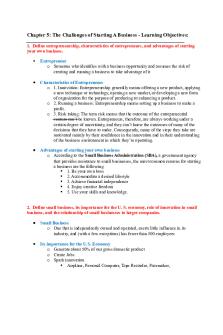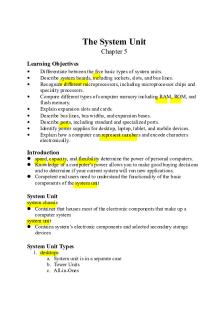Chapter 5 Notes PDF

| Title | Chapter 5 Notes |
|---|---|
| Author | Anne Simpson |
| Course | Human Resource Management |
| Institution | Conestoga College |
| Pages | 4 |
| File Size | 111.9 KB |
| File Type | |
| Total Downloads | 7 |
| Total Views | 130 |
Summary
Class notes...
Description
Chapter 5
1. Explain the strategic importance of the recruitment function Recruitment Defined ● The process of finding and attracting capable individuals to apply for employment and to accept a job offer if/when one is made to them ● Includes both purposeful and unintentional actions ● Recruiting is a two-way street: matching firms with jobs to people seeking jobs ● Recruiters are specialists within the HR department of a large organization The Recruitment Process 1. Identify job openings 2. Review job specifications 3. Examine the desired characteristics of recruits 4. Determine recruitment methods 5. Obtain pool of recruits 6. Maintain applicant interest during selection 7. Persuade chosen candidates to accept the job Strategic Importance of Recruitment Recruitment decisions have profound implications for strategic success: ● Competitive advantage from human resources ● Benefits of diversity ● Focusing on employee development ● Investing resources into recruitment 2. Discuss the constraints faced in a typical recruitment process Internal Recruiting
Advantages ● ●
●
Employee is familiar with the organization Employee is “known”, git with the organization as well as past performance as an indicator of future success Improves employee morale & motivation
Weaknesses ● ● ●
Internal competition can reduce cooperation No “new blood” so can prevent creative solutions Poor morale (possible turnover) of employees not promoted
External Recruiting
Advantages ● ●
Able to acquire skills and knowledge that may not be available within Newer ideas and novel ways of solving problems may emerge
Weaknesses ● ● ● ●
Newcomers may not fit in Newcomers take longer to learn about the organization Usually more expensive Lowered morale and motivation of current employees
Constraints on Recruitment: Organizational Policies ● ● ● ●
Promote-from-Within Policies ○ Gives present employees the first opportunity Compensation Policies ○ Must adhere to stated pay ranges Employment Status Policies ○ E.g limitations against hiring part-time International Hiring Policies ○ Foreign jobs may need to be staffed with locals
Constraints on Recruitments ● ● ● ●
● ● ●
Human Resource Plans ○ Which jobs should be filled by external recruiting vs internally? Diversity and Inclusion Programs ○ Consider employment equity programs Recruiter Habits ○ A recruiter’s past success can lead to habits Environmental Conditions ○ Leading Economic Indicators ○ Predicted Versus Actual Sales ○ Employment Statistics Job Requirements ○ Job analysis information is useful Costs ○ Or identifying and attracting recruits Inducements
3. Describe the two most common methods of applying for a job Applying for a Job
1. Submit a resume - Application Tracking System for electronic applications 2. Job Application Form - Designates the information the recruiters would like to have for each applicant - May make education credentials and employment gaps more apparent Job Applications Forms ● Personal Data (name and contact info) ● Employment Status ● Education and Skills ● Work History ● Reference ● Signature Line 4. Identify the appropriate recruiting methods for different types of jobs Recruitment Methods ● Walk-in and Write-ins ● Employee Referrals ● Advertising ○ Common, effective method of seeking recruits ○ Blind ads - the employer is not identified ○ Cost is determined by the size of the advertisement, modality, and location and distribution ○ Layout, design, and copy an advertisement should reflect the image and character of the company 5. Explain how to generate effective recruitment advertisements Recruitment Methods 1. Internet Recruiting 2. Social Media 3. Employment and Social Development Canada (ESDC) 4. Private Employment Agencies 5. Professional Search Firms 6. Educational Institutions 7. Professional & Labour Organizations 8. Canadian Forces 9. Temporary-Help Agencies 10. Departing Employees (buy-back) 11. Job Fairs 12. Contract Workers 13. Recruitment Abroad
6. Describe how to choose among the recruitment sources Choosing Recruitment Sources ● How does a recruiter choose which methods to use? ○ How many recruits are needed? ○ What is the skill level required? ○ What sources are available? ○ What has worked in the past? ○ How much is the budget? ○ Are there labour agreements that specify recruitment options? 7. List key measures for evaluating the effectiveness of the recruitment function Evaluating Recruitment ● ● ●
●
Cost per Hire ○ The dollar cost per person hired Quality of Hires and Cost ○ Quality of people hired from various sources Offers - Applicants Ratios ○ Ratio between the number of job offers and total applicants for each recruitment method Time Lapsed per Hire ○ Time taken to fill a position
Applying the Recruitment Process You run a rapidly growing company with 20 employees. Your overworked General Accountant has just quit , citing stress as his primary reason for leaving. His primary job tasks included: ● Accounts payable/receivable; HST filing, bank/credit card reconciliation; prepare financial reports; budget forecasting; employee expense reporting; WSIB payments; tax preparation; other ad hoc responsibilities as needed You need to back-fill the General Accountant role ASAP. Follow the Recruitment Process...
Similar Free PDFs

Chapter 5 - Lecture notes 5
- 15 Pages

Chapter-5 - Lecture notes 5
- 6 Pages

Chapter 5 - Lecture notes 5
- 83 Pages

Chapter 5 - Lecture notes 5
- 4 Pages

Chapter 5 - Lecture notes 5
- 20 Pages

Chapter 5 - Lecture notes 5
- 4 Pages

Chapter 5 - Lecture notes 5
- 7 Pages

Chapter 5 - Lecture notes 5
- 2 Pages

Chapter 5 - Lecture notes 5
- 3 Pages

Chapter 5 - Lecture notes 5
- 2 Pages

Chapter 5 - Lecture notes 5
- 6 Pages

Chapter 5 - Lecture notes 5
- 6 Pages

Chapter+5 - notes for chapter 5
- 8 Pages

Chapter 5 Notes 4e
- 12 Pages

Chapter 5 Notes
- 15 Pages

Chapter notes 1-5
- 72 Pages
Popular Institutions
- Tinajero National High School - Annex
- Politeknik Caltex Riau
- Yokohama City University
- SGT University
- University of Al-Qadisiyah
- Divine Word College of Vigan
- Techniek College Rotterdam
- Universidade de Santiago
- Universiti Teknologi MARA Cawangan Johor Kampus Pasir Gudang
- Poltekkes Kemenkes Yogyakarta
- Baguio City National High School
- Colegio san marcos
- preparatoria uno
- Centro de Bachillerato Tecnológico Industrial y de Servicios No. 107
- Dalian Maritime University
- Quang Trung Secondary School
- Colegio Tecnológico en Informática
- Corporación Regional de Educación Superior
- Grupo CEDVA
- Dar Al Uloom University
- Centro de Estudios Preuniversitarios de la Universidad Nacional de Ingeniería
- 上智大学
- Aakash International School, Nuna Majara
- San Felipe Neri Catholic School
- Kang Chiao International School - New Taipei City
- Misamis Occidental National High School
- Institución Educativa Escuela Normal Juan Ladrilleros
- Kolehiyo ng Pantukan
- Batanes State College
- Instituto Continental
- Sekolah Menengah Kejuruan Kesehatan Kaltara (Tarakan)
- Colegio de La Inmaculada Concepcion - Cebu